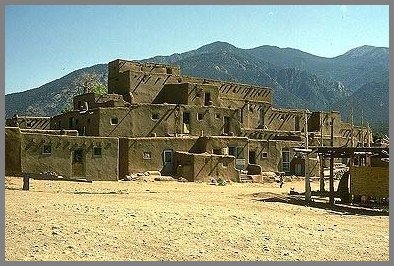Educator Debbie Reese notes some problems with a children's book:
"Pueblo" in Shoulders and Brannen's The ABC Book of American HomesThis morning, I am looking (online) at the "P" page in Michael Shoulders and Sarah S. Brannen's picture book, The ABC Book of American Homes.
The text reads:
P is for Pueblo. These communal homes were invented by the Pueblo Indians of America's Southwest. Pueblos are apartment-like dwellings with thick walls of adobe, a mixture of dirt, clay, and straw. Since pueblos are made of earthen materials, rain can damage them. For that reason, pueblos are built in very dry places. Although some pueblos are painted, many owners leave them their natural color. These pueblos blend into their surroundings as if they sprang from the earth.(Excerpted from Debbie Reese's
American Indians in Children's Literature, 9/17/09.)
Comment: Beyond the other problems Reese notes, the main problem is the entry's tone. It's too passive and negative, as if creating pueblos wasn't a real achievement. Consider:
The entry doesn't say anything positive about the invention or use of adobe. Since adobe allegedly doesn't last in rain, it sounds like an invention of limited use.The entry implies the Pueblo Indians were a bit foolish. They created a substance and then learned they could use it only in an extreme climate.The entry implies the Indians' main concern was blending in with the environment. They built pueblos to live in harmony with nature, not to shape or control it.
In this context, that sounds negative. It's a bit like crediting birds for building nests or bees for building hives. Their homes are "natural," but have no other characteristics of advanced thought or planning.Here's a rewrite that uses roughly the same number of words but stresses the Indians' active and intelligent role:
P is for Pueblo. These communal homes were developed by the Pueblo Indians of America's Southwest. Pueblos are apartment-like dwellings with thick walls of adobe, a mixture of sand, clay, and water. Adding organic material such as straw makes the structures extremely durable, and some have lasted almost 1,000 years. The well-insulated walls keep the pueblos cool in the summer and warm in the winter. Indians still build and use adobe homes in Arizona and New Mexico today.


1 comment:
I have some minor quibbles-- I think the mention of adobe's structural weakness in rain is interesting enough, at least as an elaboration as to why as a material it spread to a limited area. Perhaps something like "Adding organic material such as straw makes the structures extremely durable in suitably dry conditions"?
Second, I'm not sure about the assessment of the "sprang from the earth" language in the original... I confess that this is more due to admiration of it as a fairly pretty bit of poetic imagery than anything else, I think there's some way to preserve that in a less problematic way. Or at least I hope there is.
Post a Comment